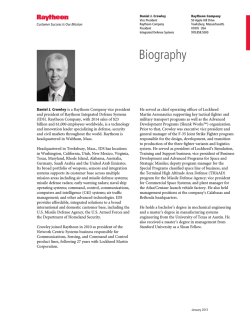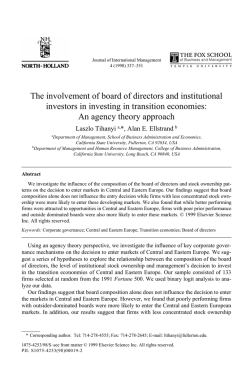
Three Generations of Industrial districts
© Investigaciones Regionales – Journal of Regional Research, 32 (2015) – Pages 75 to 87 Section Articles Three Generations of Industrial districts Marco Bellandi *, Lisa De Propris ** Abstract: The paper presents a theoretical framework for understanding the evolution of industrial districts from Marshall’s conceptualisation to today’s realities and theorisations of the industrial district as model of industrial organization and development. We discuss three generation of industrial districts: the first generations of districts were the seedbeds for the first industrial revolution. The second generations corresponded to the re-emergence of industrial districts in advanced and industrialised countries during the second half of the twentieth century, after the golden age of mass production. The current and third generation is being revealed resorting to scholarly observation. We will argue that each generation of industrial districts have emerged and grown in correspondence with specific technological, institutional and market conditions. Some evidence from the Italian case is presented. JEL Classification: L60; 014; R30; R58. Keywords: industrial district; manufacturing; local economic development. Tres generaciones de distritos industriales Resumen: El artículo presenta un marco teórico para entender la evolución de los distritos industriales desde la conceptualización de Marshall hasta las actuales realidades y teorizaciones del distrito industrial como modelo de organización industrial y desarrollo. Discutimos tres generaciones de distritos industriales: la primera generación de distritos fueron las semillas para la primera revolución industrial. La segunda generación correspondió a la reemergencia de los distritos industriales en países avanzados e industrializados durante la segunda mitad del siglo xx, después de la edad de oro de la producción en masa. La tercera y actual generación no es una cuestión de evidencia histórica, sino que está siendo revelada recurriendo a la observación científica. Sostendremos que cada generación de distritos industriales ha emergido y crecido en correspondencia con específicas * Dipartimento di Scienze per l’Economia e l’Impresa. Università degli Studi di Firenze. ** Department of Business and Labour Economics. Birmingham Business School, University of Birmingham. Received: 15 june 2015 / Accepted: 27 july 2015. 75 76 Bellandi, M., De Propris, L. condiciones tecnológicas, institucionales y de mercado. Se presenta evidencia sobre el caso italiano. Clasificación JEL: L60; 014; R30; R58. Palabras clave: distrito industrial; manufactura; desarrollo económico local. 1. The three generations of Industrial Districts The concept of industrial district (ID) re-emerged in Italy at the end of the 1970s with the success of many Made In Italy products related to the growth of agglomerations of small firms. Empirical inquiries complemented by the search for appropriate frames of interpretation took some social scientists first to raise doubts about and then reject a simplistic interpretation that downplayed the vitality of small firms agglomerations either as satellites emerging from the production decentralisation strategies of big manufacturing firms in peripheral regions or as the persistence of pre-modern industries in backward regions. The 1979 paper by Giacomo Becattini 1, where a re-discovery of Alfred Marshall’s analysis of industrial districts and external economies was presented, may be considered the official start date of the scholarly debate on the ID as a concept that refers to a form of industrial organisation by which increasing returns are realised thanks to a local division of labour among small and medium sized firms embedded in a delimited territory. Empirically, IDs appeared as places characterised by the presence of localised industries. These studies soon intersected and started to be picked up by an emerging international scholarly community working on the boundaries of new industrial organisations and new economic geographers. These aspects are quite well known in the Italian and international literature 2. In what follows we shall illustrate and reflect on the evolution of IDs and what forms they have assumed and are assuming as they change and adapt to technology and markets, but crucially persist as local engines of industrial growth. For this purpose, adopted here is an expository frame which itself is the result of recent advances and helps distinguish three generations of IDs representative of three waves of industrialization in which they have played an important and distinctive role 3. During the first wave, IDs were the seed-beds and first-comers of the industrial revolution. The second wave refers to the re-emergence of the role of IDs within 1 See Becattini (2004) for a collection of his essays on the ID, among which the English version of the 1979 paper (From the industrial sector to the industrial district...) which is the first explicit recovery of the Marshallian theme, bridging value theory and industrial organization. The paper has been re-published various times in various languages. The first English publication dates back to 1989. 2 For a collection of studies on these concepts and debates see section 2 of Becattini et al. (2009) on «From the English Roots to the Italian Revival» (Introduction by T. Raffaelli). 3 The frame of three waves could be seen as a variation on «the second industrial divide» or on «new competition» themes (see note 6). It has been introduced explicitly by Bellandi (2007). In what follows we will take advantage extensively from the contributions collected in Becattini et al. (2009), as they span in depth the three waves. Investigaciones Regionales – Journal of Regional Research, 32 (2015) – Pages 75 to 87 Three Generations of Industrial districts 77 developed countries during the second half of the twentieth century after the golden age of mass production. The third wave is now ongoing with the IDs and the new industries of the beginning of the twenty-first century. All such ages include plenty of forms of IDs, however we propose a view according to which each wave is characterized by some prevailing form under the ID general concept. They are what we call here the three generations of IDs, borrowing and modifying a terminology first used by Sebastiano Brusco in 1990 4. 2. Industrial district Mark 1 - Marshall and the industrial revolution The recovery of Alfred Marshall’s reflections on IDs has entertained a large number of scholars in the fields of economics and geography, not to mention history and sociology since the mid 1980s. Marshall’s conceptualisation of IDs in his early studies derived from the observation of what he witnessed. It shaped profoundly, and persistently, not only his views on industrial organisation, but more generally his conception of capitalism and market mechanisms (Becattini et al., 2006). In particular, significant passages in his early writings, like the Economics of Industry and the Pure Theory of Domestic Values, suggest that English IDs characterised by the presence of small firms empirically bore out the hypothesis that the economies of the division of labour cannot always be explained by large firm control. By contrast, Marshall attained compelling confirmation of the importance of sharing social experiences, exchanging information and knowledge as well as of a division of labour without centralized control (Loasby, 1998; Cooke, 2009). For Marshall, the economies arising from increases in the scale of production depend on a combination of specialisation and appropriate solutions for coordination, motivation, and cognitive support. In the case of internal economies, the solution is the unification of strategic power over decisions and management within a large firm. Internal economies require a high degree of coordination and hierarchy to maximise the efficient use of capital with labour (Hart, 2009). On the other hand, external economies are external to the firm, but «internal» to the pertinent organisational con4 Brusco (1990) referring to Italian IDs between the 1970s and 1980s saw a passage to a more deliberate use of local policy to support the vitality of the ID SMEs throughout the provision of the socalled «real services», that is marketing and knowledge services realised by local or regional public or private-public agencies working within or across IDs. He referred to IDs plus real services as IDs Mark 2, while IDs with strong socio-cultural embeddedness and without (a strong support by) real services were seen as characteristic of the take-off phases of Italian IDs in the 1960s and 1970s, IDs Mark 1. In the present paper we refer to IDs Mark 1as those featuring the first wave along the XIX century in countries leading the first industrial revolution. The actions of public and collective bodies in many of those IDs were registered as meaningful also by Marshall and this is confirmed in recent historical accounts, though their nature was probably different from the real services identified by Brusco. On the relations between socio-cultural and institutional support in IDs see Becattini et al. (2009) Section 4 on «Socio-cultural and institutional aspects» (Introduction by P. Giovannini). Brusco’s IDs Mark 2 are included in any case in what we call here as second generation IDs. Investigaciones Regionales – Journal of Regional Research, 32 (2015) – Pages 75 to 87 78 Bellandi, M., De Propris, L. text, which in IDs Mark 1 coincided with the localised socio-industrial fabric of a compact centre of industry (Marshall 1920, pp. 271-273). The aggregate resources of the industrial district must, however, be large and diverse enough to support a high degree of division of labour among firms. Social institutions (e.g. custom), business associations and public bodies (Marshall 1920, 467-469) are to complement market mechanisms in supporting the external organisation of firms, the flat governance of the division of labour among them, and thereby the realisation of external economies related to the collective scale of production. Marshall recognised that the production machine —i.e. the market and the firms— is interdependent with the society of the place and the state. The hidden centrality of the ID for a great economist such as Marshall, so alert to the empirical side of industrial organisation, is evidence of how important IDs were in the first industrial revolution and throughout the nineteenth and early twentieth centuries. The IDs Mark 1 have been seen usually as an alternative to the growing factory system in sectors less influenced by large-scale mechanisation. Recent historic studies have underlined however what was already perceived by Marshall, that is, that IDs Mark 1 were also seed-bed of the factory system, with a wide variety of organisational, social and institutional forms sometimes overlapping in the same place. 5 Within this large and evolving variety, what can be seen as the specific feature of the ID Mark 1 is the predominance of the local source of the external economies, with respect to upper and more transversal levels of production. This reflects a period when the logics of the modern market and capitalist relations and of the modern nation state were still emerging, while cities were still the fundamental basis of institutional organisation (Braudel, 1977; Pollard, 1981). From the second edition of the Principles of Economics in 1891 onwards, Marshall suggests the de-coupling of external economies from a narrow localisation of industries and from the concentration of many small businesses in the same locale (Marshall 1920, p. 266). With this decoupling, the role of «place» in increasing returns was potentially extended from a single locality of industry to different interlinked territorial levels, much as time has different interlinked scales. Marshall applied this view to the description of market and productive tendencies of his age in Industry and Trade; but, contrary to what he was able to do with the time scale, he did not give an explicit systematic account of the interplay among different interlinked places and territorial levels within market economies and capitalist development (Bellandi 2011). Nonetheless the implicit multi-territorial framework accommodated both the evolution of the industrial district model within more structured regional, national, capitalist and market spaces, and the evolution of the factory system into the lead of big national (and afterwards trans-national) firms supported by national infrastructures. With the second industrial revolution big firms, heavy industries, Fordism and mass-production became dominant. 5 See in Becattini et al. (2009) Section 2 on «Early Industrial Districts» (Introduction by A. Guenzi). Investigaciones Regionales – Journal of Regional Research, 32 (2015) – Pages 75 to 87 Three Generations of Industrial districts 79 3. Industrial districts Mark 2 - Post-fordism and the demise of mass production The second «generation» of IDs are the so-called Marshallian Industrial Districts (MIDs). They became visible and started to stand out in the mid-1970s when the golden age of mass production was showing the first signs of weakness. These IDs were constantly confronted by the concentrated economic and strategic power of large firms, powerful capitalists, and big urban systems. An early and popular explanation of this second wave of small scale production was proposed by M. Piore, C. Sabel and J. Zeitlin, who referred to the re-emergence of flexible specialization and artisanal modes of production as the «second industrial divide». Indeed, flexible specialisation presented a viable (but not necessarily dominant) alternative to mass production, generated by the increasing demand for variation and variety from the many increasing affluent consumers. 6 On the market side, the success of small scale production came from an emerging demand for more customised and differentiated goods. On the production side, the changing nature of demand altered the competitive game and Fordist-type vertically integrated productions proved too rigid and inflexible. This meant a shift back from the «factory» to «workshop» and with this, a renewed focus on the «locale of production» which includes its society and historical-cultural uniqueness (Becattini 2004). Becattini in 1990 defined such MIDs 7 as «a socio-territorial entity which is characterised by the active presence of both a community of people and a population of firms in a naturally and historically bounded area» (ibid., p. 38). MID is an ideal-typical model of a «localised industry» and it is characterised by local industrial specialisation, a decisive but not exclusive role of locally embedded centres of strategy and decision-making in the definition of local private and public investments in technical, human and social capital (endogeneity), and a structured plurality of autonomous centres of business decision-making (de-centralisation) 8. The first studies centred on the observation of the success and growth of these IDs Mark 2 in Italy as laboratories of the MID model. Italian regions had retained 6 Piore and Zeitlin investigated a lot in Italy in the first half of the 1980s, in touch with the Italians. See for example Natali and Russo (2009) on the role of Sebastiano Brusco. Piore and Sabel (1984) was an international success. The historical complexities of the two «divides» have been considered in Sabel and Zeitlin (1997). Interpretative frames in a similar vein were proposed by M. Storper, A. Scott, and M. Best, and on the side of management strategies by M. Porter. See in Becattini et al. (2009) Section 3 on «A meeting ground for the social sciences» (Introduction by C. Trigilia) and Section 5 on «Knowledge, learning and creativity» (Introduction by L. Lazzeretti). ID and IDs studies received strong «ideological» support from the 1980s international publications, as they came from prestigious American universities and interacted with Italian studies from the beginning. 7 The term and the model were proposed by Becattini in the paper on «The Marshallian district as a socio-economic notion». This essay has been re-published in Becattini (2004). 8 To be noted is that, contrary to some simplified representations, the model does not adopt a localist view of local development as depending uniquely on endogenous specialisation. See Becattini et al. (2003). Investigaciones Regionales – Journal of Regional Research, 32 (2015) – Pages 75 to 87 80 Bellandi, M., De Propris, L. the vestiges of powerful urbanised artisan systems and some industrial traditions of localised industries that had survived during the two World Wars. Furthermore, they had local political systems committed to supply such localised industrial districts with specific public goods and closely knitted social fabric (Bagnasco, 2009). International research has confirmed the presence of IDs in several other industrialised countries 9. Also important for an overall assessment of the strength of this second generation of IDs is the seemingly growing presence of nuclei of «district processes» within various types of localities, like big cities and rural areas, disclosing forms of local development more or less different from canonical district models (Becattini et al., 2003). Looking back to the MID model 25 years later, we are able perhaps to understand its meaning as a representation of IDs Mark 2. The model was intended to highlight the difference from the dominant industrial and urban models of the time. Firstly, trust allowed transaction costs minimisation along a local filière of specialised producers and markets against vertical integration and anonymous market relations. Secondly, spirit of the place and social mobilisation of collective resources, creativity and self-help directing investments in local human and technical capital were contrasted against finance, big firms and bureaucratic state agencies governing industrial investments within and across socially fragmented urban spaces. This second generation of IDs included some features of the IDs Mark 1, i.e. those less hybridized with the growing factory system of the XIX century, and more reminiscent of the guildsmerchants-crafts modes of production in the cities leading economic development in Europe before the Industrial Revolution. However, the past never comes back wearing identical clothes. Actually IDs Mark 2 emerged and developed not only thanks to their inner/exclusive features in front of windows of opportunity opened by market and technological tendencies in mid-XX century recalled before. They also featured inclusion in networks external to the local system and a more profound and conscious support from local and regional policies 10. So they were able to combine the local sources of external economies with regional and national sources, which had been suggested as a path of modern development of IDs already by the late Marshall. Considering for example the growth of Made in Italy in mid-XX, the contribution of single IDs cannot be underestimated, however nor should be ignored the role that urban systems, such as Milan, Verona and Venice, Bologna, Florence, have played both as localisation of clusters of high technology and high culture, and as marketing pivots of regional «magic circles» (Dunford and Greek, 2005) of typical industries distributed among sets of IDs. On the other hand, the economic development and role of such cities was surely supported by the industrial strength of IDs 9 See in Becattini et al. (2009), Section 6 on «Empirical Evidence» (Introduction by F. Sforzi), Section 7 on «The Italian experiences» (Introduction by M. Dunford), Section 8 on «The experiences in other industrialised countries» (Introduction by G. Dei Ottati). 10 See in Becattini et al. (2009) Section 10 (already recalled) and Section 11 on «Public policies and industrial development strategies» (Introduction by G. Solinas). See also previous note 4. Investigaciones Regionales – Journal of Regional Research, 32 (2015) – Pages 75 to 87 Three Generations of Industrial districts 81 located in their regional spaces (Merlo and Polese, 2006). So IDs Mark 2 replicated some of the core features of IDs Mark 1, whilst in addition to those, they presented some of the multi-territorial levers of ID external economies that the late Marshall wrote about but did not prevail in the context of the second industrial revolution in England. The ID Mark 2 was a model of organising manufacturing production that was able to create jobs and secure economic growth. However, this model was also in turn threatened by changes in markets and demand that had started way before their effects were completely visible. These included the fast pace and pervasiveness of digital technology, the exhaustion of incremental innovations in a winding down technological cycle, and the entry of China and South-East Asia to world market with their cheap products 11. All this started to shake some of the fundamental pillars of the ID Mark 2. Transformation has been necessary to survive the challenges, and has of course caused a shake-off with some IDs declining or dying. However, being a very resilient and adaptable system, the ID —as an organisational form of industrial development— has in our view found ways to reproduce some of its inner strengths and to combine them with new factors. 4. Industrial districts Mark 3 - In the age of global production and social networks Globalisation has changed the scale of socio-economic activities since the 1990s. It has coincided with the ever increasing flows of goods, services, knowledge and people along what appear to be global networks that span across an increasing number of regions and countries. The emergence of global value chains across regions and countries has thrown places into a global space in a very short period. All this poses in general two challenges to IDs forcing them to adapt, change, re-invest or decline (Becattini et al., 2009a) 12. One is the fast pace and pervasiveness of technological change and the inevitable encroachment of science-based knowledge in the world of production. Radical and pervasive changes in the scientific base of industries are trickling down towards consumers through rivulets of applications. The other is the nature, intensity and scale of increasingly globalised production processes. The globalisation of production created a divide between high-cost and low cost economies. It changed global and domestic competition with newly industrialising countries being able to produce at lower labour costs. China and South East Asia were determined to industrialise starting from traditional sectors and this meant that they entered the world market with aggressive export strategies initially in tradi11 See in Becattini et al. (2009) Section 9 on «The experiences in emerging and developing countries» (Introduction by W. Sengenberger). 12 See in Becattini et al. (2009) Section 5 (already recalled), and Section 10 on «Global challenges» (Introduction by E. Rullani). Investigaciones Regionales – Journal of Regional Research, 32 (2015) – Pages 75 to 87 82 Bellandi, M., De Propris, L. tional industries’ market segments. Localised industries, clusters, specialized towns are also found as important bases of the industrial growth in the emerging economies. In some cases they present some of the features of IDs Mark 1 or 2 (a discussion of this is beyond the scope of this paper —see note 12). Also demand became «global»: middle and low-end markets in traditional markets disappeared for IDs Mark 2 due to cost competition. Instead they had to retreat and secure high-end market niches dominated by imperfectly competition and inelastic demand thanks to branding, customisation or design intensiveness. These issues again marked a push towards changes in the internal structure of IDs, in who are the key players and in what processes can support their endogenous mechanisms to create and re-produce competences and innovations. A full picture of the ID Mark 3 is still in the making; we are here sketching in our view what are features that would allow us to still recognize in them cases of ID, and what are the changes that have nevertheless occurred to enable their resilience. The competitive advantage of IDs Mark 2 was in their ability to produce innovation and in particular incremental innovation thanks to the endogenous processes of creation and diffusion of practical knowledge in the local innovation system; and to combine this into territorially enlarged circles of exchange with codified knowledge thanks to well-defined trade and knowledge gate-keepers. This has been threatened by the emergence of a new techno-economic paradigm that is re-configuring the technological and market content in almost all sectors. The challenge for local firms and IDs is to accept the obsoleteness of some of their internal accumulated competences and the necessity to engage openly and widely with external sources of knowledge: this implies to extend quality and intensity of the ID external economies produced at regional, national and international scale, and to reduce the local social and cognitive self-containment. External influences are coming from relations with the national University system, with international networks of innovation-related actors, with international sub-contractors or client firms, as well as with urban creative contexts (Boix et al., 2013). In fast changing and globalised markets, these external forces challenge the established set of well-absorbed knowledge and practises that had steered and operated innovation and production processes in IDs Mark 2. It is becoming crucially important that new channels and new actors are activated to enable the absorption, translation and combination of external knowledge. Secondly, as investment in R&D is becoming increasingly important against a traditional innovation process based on incremental and learning-by-doing innovations, the need to appropriate the returns on such investment are threatening firms’ willingness to cooperate and exchange ideas within IDs. This is altering not only the relations between scientific and «practical/tacit» knowledge, but also the delicate balance between cooperation and competition that drives industrial districts’ vitality and dynamism. So IDs Mark 3 are changing their internal structure and adapting their production organisation to take these two challenges. We see already that some are very successInvestigaciones Regionales – Journal of Regional Research, 32 (2015) – Pages 75 to 87 Three Generations of Industrial districts 83 ful and have secured market leadership worldwide. The size of firms in this third generation of IDs varies from micro to large firms; some concentration of firms in groups and the growth in size of firms has been necessary to enhance financial capacity to invest in design and creativity upstream and advertising and marketing downstream; open knowledge networks lead the vitality of SMEs sub-systems (Lombardi, 2003); regional and national policies of development aim more explicitly to networks of innovators and platforms of innovation (technological clusters and innovation poles) liaising among cities and IDs (Caloffi and Marliani, 2011); the non-market organisation of production processes has extended beyond the locale with the district internal value chain being now plunged in trans-local and trans-international value chains (Trullen et al., 2013), but also developing trans-local external economies (Bellandi and Caloffi, 2009). These transformations are supported by the growing ease of international communications, sometimes reinforced by ties, maintained by the communities of migrants, between the old and the new home, according either to the logic of ethno-industrialization or to the working of international research and training or cultural networks. It is no longer a matter of organising international trade fairs, as at best IDs Mark 2 were used to do. It is important to be promoters and to participate in the construction of multi-scale social and cognitive networks that stretch from local to global, exploiting local symbolic resources meeting potentially a global attention: these explain the importance of the locale as they make the place a global reference point for the exchange of ideas on specific professional and socio-cultural issues, whilst at the same time leading the coalescence of new senses of belonging for local the community (Belussi and De Propris, 2013). So from external economies inside the district, we suggest we can see the emergence of «wired economies» inside the global-local value chain for those IDs which have been able to reconcile competences embedded and accumulated inside the district with external, codified, scientific knowledge coming from university or research organisations. Despite their footlessness, also international multi- national enterprises have understood the value of the «stick knowledge» that is cumulated in IDs and have decided to locate there innovation and knowledge-intensive functions (De Propris et al., 2005, Hervas and Boix, 2013). Furthermore ID process are more clearly identified also within local production systems that are localised in metropolitan or in rural areas, such as high-tech sectors, design, multi-media, cultural tourism, agribusiness, agro- tourism. It has also to be considered the resilience of some IDs which were the helm of the second generation. Their resilience and current on-going success has been somewhat underestimated or down played. They have been able to thrive by embracing a kind of generational transformation thanks to which they now have become or are in process of becoming IDs Mark 3. Indeed, evidence shows that particularly relevant has been the emergence of medium sized companies and groups within IDs, with the latter growing in number in the most successful IDs. Larger size has enabled firms to maintain their roots in the district whilst extending their Investigaciones Regionales – Journal of Regional Research, 32 (2015) – Pages 75 to 87 84 Bellandi, M., De Propris, L. production and market organisation at the national and international level (Coltorti, 2013). For example, the international financial crisis that started in 2008 hit severely the Italian industrial complex, and could have represented the end of a meaningful role for Italian IDs in our time. Instead their exports have started to recover as early as 2010 and experienced sustained growth in 2011 with a 15% rise to non-EU countries, and 8.3% rise to EU countries. This took the overall ID export value to the same level they were 2008. Best performing sectors in exports include: high tech machinery and equipment (up 15% in 2010-11); leather products (up 17%); textiles and garments (up 12%); home design (up 5%); food and wine (up 11%) (Belussi and De Propris, 2013). Despite appearing so different, the model of the ID Mark 3 remains faithful to its basics: that is the importance of the place. As manufacturing is becoming increasingly characterised by customisation and servitisation, the competitive dynamics are again changing and —away from homogenous markets—, innovation, design-intensity, immateriality and specialisation are more and more crucial. It is indeed in these markets that evidence shows that IDS are renewing their competitive advantage, with a blend of old and new, and combination of local with regional, national and global. 5. Conclusions The IDs are seen in this paper as a «species» (Loasby, 1998), adapting to various conditions and forms, finding niches in different ages and places of capitalism. We have recalled a descriptive frame that defines three ages where waves of areas and arenas for IDs have promoted industrial development: the first industrial revolution, the second divide after the second industrial revolution, the contemporary age of globalization and digital divide. The specific advance proposed in this paper is the association of the three waves with three different ideal-types of IDs, characterising widespread successful adaptations of the ID general model to the opportunities and threats of those ages. Of course the real world variety of forms goes well beyond this and other possible, even less synthetic classifications. The following Table 1 presents an outline of what distinguishes in our view the three generations of IDs. The stylised differences are summarised with the help of four axes. Different models of local industrial development are generally identified along two axes: the industrial organisation and the socio-cultural ones (Becattini et al. 2003). We give an articulation here and explicitly acknowledge the changing role which we have observed for two structural factors included in principle within the two first axes: collective action (with public support) and multi-territorial networks helping ID external economies. This classification is the result of a journey to reach a better understanding of how the conceptualisation of IDs has evolved to mirror empirical observations. We have here collected our very recent reflections as scholars are grappling with a conundrum: Investigaciones Regionales – Journal of Regional Research, 32 (2015) – Pages 75 to 87 Three Generations of Industrial districts 85 Table 1. Three Generations of Industrial Districts Local Industrial Organisation Socio-cultural embeddedness Collective action Multi-territorial network ID Mark 1 The IDs as the first-comers in countries leading the industrial revolution Various combination of artisan modes of production with the emerging factory system. Local socialcultural embeddedness of small and medium sized firms and markets necessary but not a distinctive feature. Local aid combined with old pre-nation state ways of governance. — National markets. — Export orientation for district products. — Migrations and attraction of skilled labour. ID Mark 2 Re-emergence of IDs in the developed countries after the golden age of mass production — Flexible specialisation. — Versatile integration. — Decentralised creativity within local small and medium sized firms systems. — Incremental innovation. Local embeddedness relatively high with respect to large urban systems and poles led by big firms. — Local community market inside IDs. — Real services at the local and regional level. As above, plus: — Regional relations between IDs and larger cities. ID Mark 3 Surfing knowledge societies, global social networks, global inputs and final markets — Increasing sectoral variety. — Increasing role of knowledge from outside. — Flagship role of medium sized company or networks. — From local embeddedness to local anchoring. — Local skills, heritage and authenticity. — Access to regional and national platforms for networks of innovators. — Engagement with international trans-local service providers liaising across IDs. — Global exports markets (logistics, marketing, retailing, promotion). — Coordination of global value chains. — Liaising local knowledge community with a global consumers’ community. how is it possible in the era of globalisation and multi-national conglomerate that some IDs are world leaders? Does place still matter? This paper is the first stop of our journey. As we compare and contrast the three different generations of IDs, we suggest for instance that IDs Mark 1 are seen as less specialised in terms of modes of production, more dependent on the organisation of local Guilds or Associations, and less dependent on networks external to the ID than those of the second wave. IDs Mark 2, largely corresponding to the (neo-) Marshallian ID, though characterised with respect Investigaciones Regionales – Journal of Regional Research, 32 (2015) – Pages 75 to 87 86 Bellandi, M., De Propris, L. to competing industrial models (big firms worlds) by the strength of local factors of production and social belonging, are striving in a world where the inclusion in regional policies and networks of production and marketing are necessary and practiced if not well understood. Still, knowledge for flexibility, variety and innovation depends strongly on local networks. With IDs Mark 3 the «knowledge communities» change their scale in a hyper connected world where information and social images hit and change and post-industrialised and emerging economies combine quick at an enlarged scale. Maybe if Marshall was observing now how industries and production are organised in specific places and also across places, he would still think up the concept of industrial district. IDs are clear manifestations of some basic forces shaping the evolution of the industrial organisation of places. Industrial change is not space-blind. References Bagnasco, A. (2009): The governance of industrial districts, in Becattini et al. (2009). Becattini, G. (2004): Industrial Districts: A New Approach to Industrial Change, Cheltenham, Edward Elgar Publishing. Becattini, G., Bellandi, M., Dei Ottati, G., and Sforzi, F. (2003): From industrial districts to local development. An itinerary of research, Cheltenham, Edward Elgar Publishing. Becattini, G., Bellandi, M., De Propris, L. (eds.) (2009): The Handbook of Industrial Districts, Cheltenham, Edward Elgar Publishing. — (2009a): «Critical nodes and contemporary reflections on industrial districts: An introduction», in Becattini (2009). Bellandi, M. (2007): «Industrial districts and waves of industrialization: A rich and contested terrain», Scienze Regionali. Italian Journal of Regional Science, 6 (2), 7-33. — (2011): «Some remarks on the interlinked territorial scales of Marshallian external economies», in Raffaelli, T., Nishizawa, T., and Cook, S. (eds.), Marshall, Marshallians and Industrial Economics, London, Routledge. Bellandi, M., and Caloffi, A. (2008): «District internationalisation and trans-local development», Entrepreneurship and Regional Development, 20 (6), 517-532. Belussi, F., and De Propris, L. (2013): «They are industrial districts, but not as we know them!», in Giarratani, F., Hewings, G. J. D., and McCann, P. (eds.), Handbook of Industry Studies and Economic Geography, Cheltenham, Edward Elgar Publishing. Boix, R., Lazzeretti, L., Capone, F., De Propris, L., and Sanchez, D. (2013): «The geography of creative industries in Europe: Comparing France, Great Britain, Italy and Spain», in Lazzeretti, L. (ed.), Creative Industries and Innovation in Europe: Concepts, Measures and Comparative Case Studies, London-New York, Routledge, 23-44. Braudel, F. (1977): Afterthoughts on Material Civilization and Capitalism, Baltimore, Johns Hopkins University Press. Brusco, S. (1990): «The idea of industrial districts: its genesis», in Pyke, F., Becattini, G., and Sengenberger, W. (eds) (1990), Industrial Districts and Inter-firm Cooperation in Italy, Geneva, International Institute for Labour Studies. Caloffi, A., and Mariani, M. (2011): «Shaping regional policy responses: The design of innovation poles», Policy Studies, 32 (4), 413-428. Coltorti, F. (2013): «Italian Industry, Decline or Transformation? A Framework», European Planning Studies, 21 (12), 2037-2077. Investigaciones Regionales – Journal of Regional Research, 32 (2015) – Pages 75 to 87 Three Generations of Industrial districts 87 Cooke (2009): «Technology Clusters, Industrial Districts and Regional Innovation Systems», in Becattini et al. (2009). De Propris, L., Driffield, N., and Menghinello, S. (2005): «Local Industrial Systems and the Location of FDI in Italy», International Journal of the Economics of Business, 12 (1), 105-121. Dunford, M., and Greco, L. (2005): After the Three Italies. Wealth, Inequality and Industrial Change, Oxford, Blackwell Publishing. Hart, N. (2009): «External and internal economies», in Becattini et al. (2009). Hervás, J. L., and Boix, R. (2013): «The Economic Geography of the Meso-global Spaces: Integrating Multinationals and Clusters at the Local-Global Level», European Planning Studies, 21(7), pp. 1064-1080. Loasby, B. (1998): «Industrial Districts as Knowledge Communities», in Bellet, M., e L’Hammet, C. (eds.), Industry, Space and Competition, Cheltenham, Edward Elgar Publishing. Lombardi, M. (2003): «The Evolution of Local Production Systems: the Emergence of the “Invisible Mind” and the Evolutionary Pressures Towards More Visible “Minds”», Research Policy, 32 (8), 1443-1462. Marshall, A. (1920): Principles of Economics, 8th edn, London, Macmillan (1st edition 1890). — (1919): Industry and Trade, London, Macmillan. Merlo, E., and Polese, F. (2006): «The Emergence of Milan as an International Fashion Hub», The Business History Review, 80 (3), 415-447. Natali, A., and Russo, M. (2009): «The Italian revival from the industrial policy ground», in Becattini, et al. (2009). Piore, M. J., and Sabel, Ch. F. (1984): The Second Industrial Divide. Possibilities for Prosperity, New York, Basic Books. Pollard, S. (1981): Peaceful Conquest. The Industrialization of Europe 1760-1970, Oxford, Oxford University Press. Raffaelli, T., Becattini, G., and Dardi, M. (eds.) (2006): The Elgar Companion to Alfred Marshall, Cheltenham, Edward Elgar Publishing. Sabel, C. F., and Zeitlin, J. (1997): World of Possibilities. Flexibility and Mass Production in Western Industrialization, Cambridge U.K., Cambridge University Press. Trullén, J., Boix, R., and Galletto, V. (2013): «An insight on the unit of analysis in urban research», in Kresl, P. K., and Sobrino, J., Handbook of Research Methods And Applications In Urban Economies, Northampton, Mass: Edward Elgar. Investigaciones Regionales – Journal of Regional Research, 32 (2015) – Pages 75 to 87
© Copyright 2025






